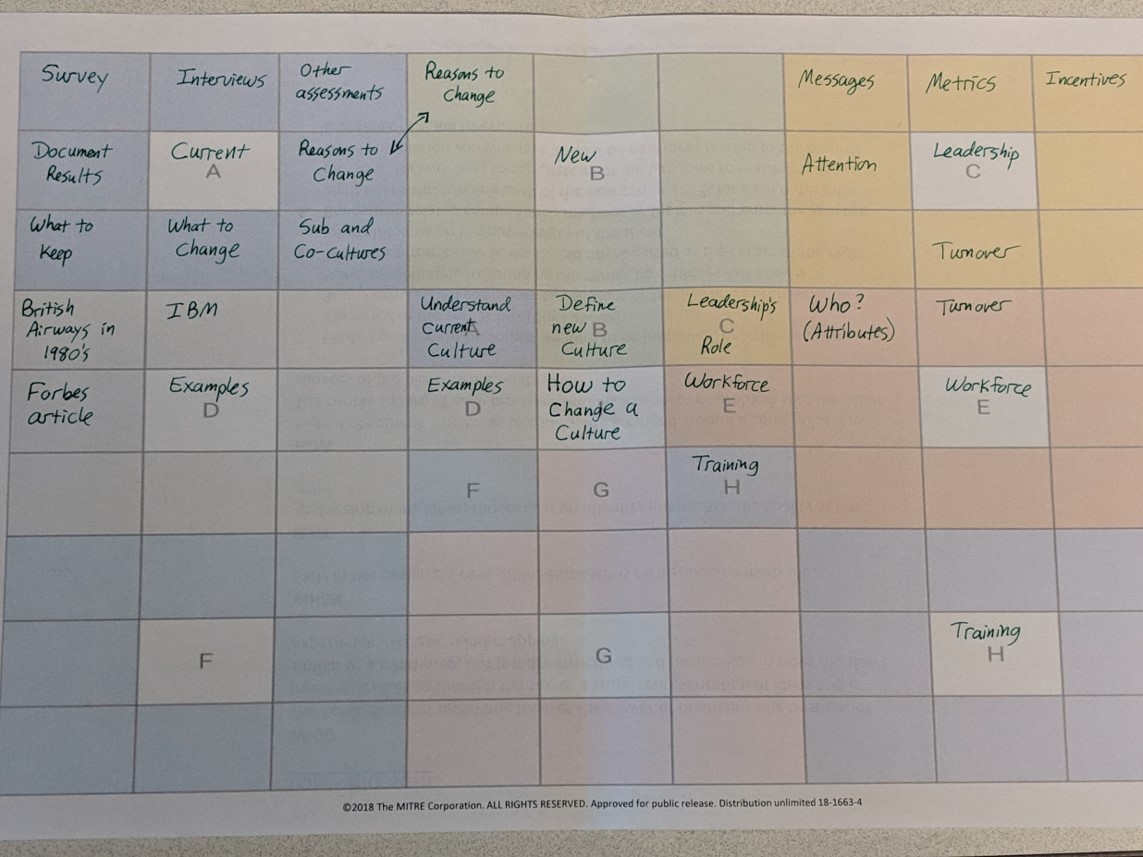by dbward | Jun 3, 2019 | Team Toolkit
Several members of Team Toolkit were recently interviewed for MITRE’s new Knowledge-Driven Podcast. In this podcast series, Cameron Boozarjomehri interviews technical leaders at MITRE who have made knowledge sharing and collaboration an integral part of their practice. Find the link to the full interview below.
Interview with Dan Ward, Rachel Gregorio, and Jessica Yu on MITRE’s Innovation Toolkit
by dbward | May 20, 2019 | Tools 101
Last week. Rachel’s blog post looked at the importance of asking Why. This week we’ll take a closer look at the Problem Framing Canvas she mentioned. It’s designed to be used with a team to establish a clear consensus about what problem you’re trying to solve.
When I’m leading one of these sessions, I like to give everyone a copy of the canvas on 11×17 paper, so there’s plenty of room to write. I start by setting a timer for 4 minutes and inviting everyone to spend a little quiet writing time, mostly focused on the first box on the upper left of the canvas (the “What’s the problem?” box).
Then we use the questions on the canvas to guide the discussion (usually 60-90 minutes) and explore different facets of the problem.
In the last 10-15 minutes, we focus on the big box at the bottom (“No, really, what’s the actual problem?”) to document the team’s shared understanding of the problem. The transformation from our initial problem statement to the final problem statement is usually quite striking.
Get your copy of the Problem Framing Canvas (and instructions on how to use it) on the Problem Framing page.

by dbward | Apr 29, 2019 | Tools 101
This week’s post is about an ideation tool called the Lotus Blossom.
This colorful & simple tool is like Mindmapping on a grid. It helps people go deeper / get more creative than a standard brainstorming session. Also, engineers tend to LOVE this one.
The photo below shows an example of a partially filled-out Lotus Blossom. To get started write the topic, problem, or concept you’re working on in the center box. In the example I wrote Culture Change. In the 8 colorful boxes around it (A-H) write down facets of the problem / topic / etc. In my example, I wrote understand the current culture, define the new culture, leadership’s role, and so on.
Next, expand the blossom from the central box to the outer boxes (aka the blossoms). To do this, just copy the words from the middle grid to the lettered boxes on the outside of the grid. You’ll see the word Current in the white box in the upper left corner.
Then add the next level of detail in the colored boxes around each blossom. So Current Culture might involve doing a survey, performing interviews, and documenting our research results.
Keep going until you’ve filled in all the boxes.
Full instructions and a downloadable template are available here.
by dbward | Apr 1, 2019 | Uncategorized |
We’ve got a guest blogger this week – ITK superfan and creative partner Liz Borseti, who shares her story of working with Team Toolkit.
As a member of MITRE’s strategic communications team, I thought I knew the most creative people who work at the company. From writers to designers to photographers, my colleagues are brimming with imagination. So when I was asked to work on a communications plan for the new Innovation Toolkit, I figured it was an ordinary assignment. We would bring an artistic perspective to the table, using a part of the brain most of our engineering colleagues don’t usually tap into.
But from the first meeting with Team Toolkit, I was surprised and happy to learn that I was wrong – creativity and imagination exist in abundance across the organization. And ITK turned out to be one of the most creatively intelligent and collaborative projects I have ever had the pleasure to work on.
As we worked diligently to evolve items like the ITK website and logo, there was a constant back and forth between the teams, learning from each other and building upon each other’s design ideas. Where strategic communications brought expert knowledge of writing, editing, and design, ITK complemented with user-centric concepts, toolkit expertise, and even a cartoon series.
Team Toolkit even encouraged our communications team to use the Premortem tool as we designed a pamphlet for the Premortem tool (Toolception!).
Team Toolkit has the skills to extract the maximum potential of any team or individual. Along with their toolkit, they bring a positive, forward-thinking attitude to every project. I was lucky to experience this first hand as we completed some great work together, using the power of collaboration and systemic creative thinking.
For anyone looking to deliver mission impact on their project, ITK is the place to start. Team Toolkit are not just curators for ITK, but they truly believe in the power of innovative thinking to deliver success for MITRE, our sponsors, and our mission.
Liz Borseti
ITK collaborator, user, and superfan

by dbward | Mar 4, 2019 | Team Toolkit
We have a lot of fun telling people about the Innovation Toolkit – in person, in workshops, and in briefings. But we know we can’t reach everyone, so we recruited two comic characters to help us out.
Janet and Morgan first appeared in a comic Dan wrote for UX Magazine. When we launched ITK, we called them back into action to tell the ITK story. Download your own copy of The Comic Guide To The Innovation Toolkit right here, and maybe even pass the link along to your friends!


